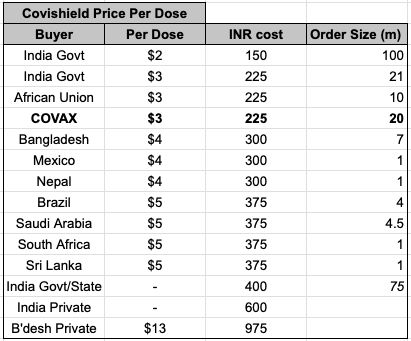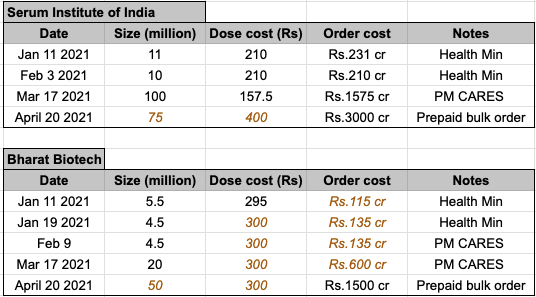
This thread addresses Indian vaccine prices and orders.
Covishield sale price. Source: unicef.org/supply/covid-1…
1/
Covishield sale price. Source: unicef.org/supply/covid-1…
1/

Observations:
1. SII-AZ signed the Covishield licence prodn deal to enable COVAX supply, so $3/dose is baseline
2. SII supplied 50m doses at that price, another 100m doses at 66% of that price to Indian govt.
2/
1. SII-AZ signed the Covishield licence prodn deal to enable COVAX supply, so $3/dose is baseline
2. SII supplied 50m doses at that price, another 100m doses at 66% of that price to Indian govt.
2/
The second deal significantly stressed SII, supplying so far below cost. Same vaccine made in EU goes for $4-6 (Rs.300-450) per dose. SII pays ~Rs.75 per dose as royalty to AZ. At Rs.150/dose it makes only Rs.75.
3/
3/
The latest SII price of Rs.400/dose aligns it with parent AZ price for supplies to govt. It also lets SII recoup losses on the 100 milion dose deal at $2 that it supplied to Indian Govt in March-April. So lets look at the deals more:
4/
4/
These are all the deals with @SerumInstIndia and @BharatBiotech and Indian govt so far.
Orange numbers are those extrapolated based on other known info.
5/
Orange numbers are those extrapolated based on other known info.
5/

One of the criticisms made is that India was slow to order in bulk. However this is not true - ordering was ahead of monthly consumption:
6/
6/

India began vaccinations on Jan 16, and orders for that month are conservative since efficacy was unclear then especially for Covaxin, which received preliminary EUA before Phase 3 results in March.
7/
7/
By March, Govt placed successive bulk orders including the 100 million dose @ $2 deal with SII . This enabled rapid vaccination in March and April.
With the new 3000+1500 cr order to SII+BB, govt has accelerated order and payment process from March.
8/
With the new 3000+1500 cr order to SII+BB, govt has accelerated order and payment process from March.
8/
Unlike US drugs with high capital costs, SII is a license mfg entity and just needs good order volume with around a month's lead time, e.g. the March 100m dose order is currently being consumed.
9/
9/
Separately, Govt has helped Bharat Biotech scale up production: pib.gov.in/PressReleasePa…
It followed it up days later with a 50m dose order.
10/
It followed it up days later with a 50m dose order.
10/
The current advance orders will enable SII to scale up over 100m doses per month. BB has stated it can produce 60m doses/month, more than 10x current production. Hopefully they'll achieve that.
11/
11/
Additional vaccine supply options include Sputnik V (order details unknown), Zycov-D (phase 3 trials incomplete).
12/
12/
It must be remembered that Govt procured vaccines at negotiated cost and then supplied it to all states for Rs.0. Only private hospitals were allowed to charge a subsidised Rs.150+100 admin fee. This is far below cost. Govt has been paying logistics costs so far.
13/
13/
Under SII's new price structure, BOTH Govt and states pay Rs.400 per dose. Private entities pay Rs.600. Govt has said it will continue to make the vaccines available free of cost at its CVCs.
14/
14/
In effect, govt has spend at least Rs.7000 cr in total on vaccine procurement which it paid out of Union Health Min and PM CARES funds. States have not had to pay for this so far.
15/
15/
Going forward, both Govt and states face an equitable arrangement - both pay Rs.400. SII gets orders at a price aligned with low end of AZ prices elsewhere - already the cheapest mass produced vaccine.
16/
16/
Onus is now on states and private entities to follow up the Rs.4500cr in Govt orders in April ,with their own. With large bulk orders, SII can scale up to 100m doses/month or more quickly, and same for BB.
Continued volume orders are critical to driving production.
17/17
Continued volume orders are critical to driving production.
17/17
Some wondered why BB 5.5m order was worth less than 4.5m one. BB donated 1.65m doses of its first order to thank Govt for supporting it early. So cost is price of remaining 3.85m doses.
• • •
Missing some Tweet in this thread? You can try to
force a refresh





